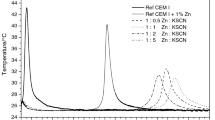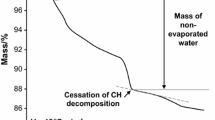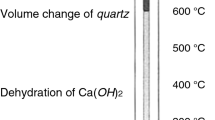Abstract
Six phosphonates, comprising the three acids aminotri(methylenephosphonic acid) (ATMP), 1-hydroxyethylidene-1,1-diphosphonic acid (HEDP) and diethylenetriaminepenta-(methylenephosphonic acid) (DTPMP) and their corresponding sodium salts Na5ATMP, Na4HEDP and Na6DTPMP, were added to Portland cement in dosages ranging from 0.03 to 0.09%, at a constant water/cement ratio of 0.35 and their conduction calorimetric behaviour was investigated up to 72 h. The induction period, the time to attain the maximum heat effect and the integral heat developed at different times were determined. All phosphonates increased the induction period, from about 3 h to greater than 72 h, with respect to the reference cement with an induction period of 2 h. The acid phosphonates were more effective retarders than their corresponding salts. At a concentration of 0.05% the induction period extended from 10.1 to 21.1 h with the acids and only from 4.1 to 16.2 h with the salts. DTPMP was the most effective retarder among all the phosphonates, a concentration of 0.05% producing an induction period of 21.1 h and an exothermic inflection at 42.4 h compared with values of 2.2 and 7.9 h, respectively, for the reference. The corresponding salt (Na6DTPMP) was the most efficient of all the salt retarders. At a concentration of 0.05%, the induction period was extended to 16.2 h and the exothermal inflection to 31.4 h. In most instances the degree of extension of the induction period increased with the dosage of retarder. Phosphonates appear to be much more efficient retarders than many other retarders used in concrete practice.
Resume
On a ajouté au ciment Portland six phosphonates, comprenant les trois acides aminotri (acid méthylènephosphonique) (ATMP), 1-acide hydroxyéthylidène-1,1-acide diphosphonique (HEDP) et diéthylènetriaminepenta(acide méthylènophosphonique) (DTPMP) et les sels de sodium correspondants Na5ATMP, Na4HEDP et Na6DTPMP, à des dosages allant de 0,03 à 0,09%, avec un rapport eau/ciment constant de 0,35. On a étudié leur comportement sous conduction calorimétrique pendant une durée de 72 h.
On a déterminé la période d’induction, le temps nécessaire pour atteindre l`effet de chaleur maximal et la chaleur intégrale produite à certains moments. Tous les phosphonates ont augmenté la période d’induction de 3 h à plus de 72 h, par rapport au ciment de référence qui présente une période d’induction de 2 h. Les phosphonates sont des retardateurs plus efficaces que les sels qui leur correspondent. Pour une concentration de 0,05%, la période d’induction est passée de 10 à 21,1 h avec les acides, et seulement de 4,1 à 16,2 h avec les sels.
Le DTPMP a été le retardateur le plus efficace parmi les phosphonates: une concentration de 0,05% a déterminé une période d’induction de 21,1 h et une manifestation exothermique à 42,4 h, par rapport à des valeurs respectivement de 2,2 et 7,9 h pour le ciment de référence. Le sel correspondant (Na6DTPMP) a été le plus efficace de tous les sels retardateurs. Pour une concentration de 0,05, la période d’induction a atteint 16,2 h et la manifestation exothermique 31,4 h. Dans la plupart des cas, le degré d’allongement de la période d’induction était en relation avec le dosage de retardateurs. Les phosphonates semblent être bien plus efficaces que beaucoup d’autres retardateurs utilisés dans la pratique du béton.
Similar content being viewed by others
References
Nielson, E. B., ‘Well Cementing’ (Elsevier, Amsterdam, 1990).
Ramachandran, V. S., ‘Concrete Admixtures Handbook’ (Noyes, New Jersey, 1984).
Ramachandran, V. S., Feldman R. F. and Beaudoin, J. J., ‘Concrete Science’ (Heyden, London, 1981).
Dodson, V., ‘Concrete Admixtures’ (Van Nostrand Reinhold, New York, 1990).
Rixom, M. R. and Mailvaganam, N. P., ‘Chemical Admixtures for Concrete’ (Spon, London, 1986).
Brown, P. W. (ed.) ‘Cements Research Progress (Annual Publication)’ (American Ceramic Society, Westerville, USA, 1989).
Ramachandran, V. S., ‘Possible states of chloride in the hydration of tricalcium silicate in the presence of calcium chloride’,Mater. Constr. 4 (1971) 3–12.
Idem, ‘Admixture and addition interactions in the cement-water system’,Il Cemento 83 (1986) 13–38.
Young, J. F., ‘The influence of sugars on the hydration of tricalcium aluminate’, in Proceedings of 5th International Symposium on the Chemistry Cements, Tokyo, 1968, Vol. II (Cement Association of Japan, Tokyo) pp. 256–267.
Diamond, S., ‘Interactions between cement minerals and hydroxycarboxylic acid retarders III: infrared spectral identification of the aluminosilicate complex’,J. Amer. Ceram. Soc. 55 (1972) 405–408.
Lieber, W., ‘Influence of zinc oxide on the setting and hardening of Portland cement’,Zem. Kalk. Gips 20 (1967) 91–95.
Ramachandran, V. S. and Lowery, M. S. ‘Conduction calorimetric investigation of the effect of retarders on the hydration of Portland cements’,Thermochim. Acta 195 (1992) 373–387.
Suguma, T., Carciello, N. R. and Gray, G., ‘Alkali carbonation of calcium aluminate cements: Influence of set retarding admixtures under hydrothermal conditions’,J. Mater. Sci. 27 (1992) 4909–4916.
Ramachandran, V. S., ‘Effect of retarder/water reducers on slump loss in superplasticized concrete’, in ‘Developments in the Use of Superplasticizers’, Special Publication 68 (American Concrete Institute, Detroit, 1981) pp. 393–407.
Monsanto Company, ‘Dequest Phosphonates by Monsanto, An Introductory Guide’, Publication No. 9151 (Monsanto Co., St. Louis, Missouri, USA, 1990) pp. 1–6.
Author information
Authors and Affiliations
Rights and permissions
About this article
Cite this article
Ramachandran, V.S., Lowery, M.S., Wise, T. et al. The role of phosphonates in the hydration of Portland cement. Materials and Structures 26, 425–432 (1993). https://doi.org/10.1007/BF02472943
Issue Date:
DOI: https://doi.org/10.1007/BF02472943





